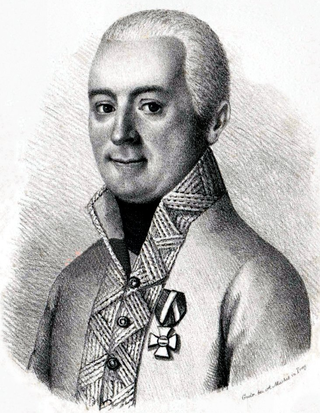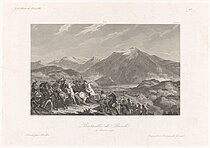
The Battle of Arcole or Battle of Arcola was fought between French and Austrian forces 25 kilometres (16 mi) southeast of Verona during the War of the First Coalition, a part of the French Revolutionary Wars. The battle saw a bold maneuver by Napoleon Bonaparte's French Army of Italy to outflank the Austrian army led by József Alvinczi and cut off its line of retreat. The French victory proved to be a highly significant event during the third Austrian attempt to lift the siege of Mantua. Alvinczi planned to execute a two-pronged offensive against Bonaparte's army. The Austrian commander ordered Paul Davidovich to advance south along the Adige River valley with one corps while Alvinczi led the main army in an advance from the east. The Austrians hoped to raise the siege of Mantua where Dagobert Sigmund von Wurmser was trapped with a large garrison. If the two Austrian columns linked up and if Wurmser's troops were released, French prospects were grim.

Jean-Mathieu-Philibert Sérurier, 1st Count Sérurier led a division in the War of the First Coalition and became a Marshal of the Empire under Emperor Napoleon. He was born into the minor nobility and in 1755 joined the Laon militia which was soon sent to fight in the Seven Years' War. After transferring into the regular army as an ensign, he was wounded at Warburg in 1760. He fought in the Spanish-Portuguese War in 1762. He married in 1779 after a promotion to captain. A newly minted major in 1789, the French Revolution sped up promotion so that he was colonel of the regiment in 1792. After leading Army of Italy troops in a number of actions, he became a general of brigade in 1793 and a general of division the following year.

The Battle of Castiglione saw the French Army of Italy under General Napoleon Bonaparte attack an army of the Habsburg monarchy led by Feldmarschall Dagobert Sigmund von Wurmser on 5 August 1796. The outnumbered Austrians were defeated and driven back along a line of hills to the river crossing at Borghetto, where they retired beyond the Mincio River. The town of Castiglione delle Stiviere is located 10 kilometres (6 mi) south of Lake Garda in northern Italy. This battle was one of four famous victories won by Bonaparte during the War of the First Coalition, part of the French Revolutionary Wars. The others were Bassano, Arcole, and Rivoli.

In the Battle of Rovereto on 4 September 1796 a French army commanded by Napoleon Bonaparte defeated an Austrian corps led by Paul Davidovich during the War of the First Coalition, part of the French Revolutionary Wars. The battle was fought near the town of Rovereto, in the upper Adige River valley in northern Italy.
Baron Paul Davidovich or Pavle Davidović became a general of the Austrian Empire and a Knight of the Military Order of Maria Theresa. He played a major role in the 1796 Italian campaign during the French Revolutionary Wars, leading corps-sized commands in the fighting against the French army led by Napoleon Bonaparte. He led troops during the Napoleonic Wars and was Proprietor (Inhaber) of an Austrian infantry regiment.

The Battle of Lonato was fought on 3 and 4 August 1796 between the French Army of Italy under General Napoleon Bonaparte and a corps-sized Austrian column led by Lieutenant General Peter Quasdanovich. A week of hard-fought actions that began on 29 July and ended on 4 August resulted in the retreat of Quasdanovich's badly mauled force. The elimination of Quasdanovich's threat allowed Bonaparte to concentrate against and defeat the main Austrian army at the Battle of Castiglione on 5 August. Lonato del Garda is located near the SP 668 highway and the Brescia-Padua section of Autostrada A4 to the southwest of Lake Garda.
Giovanni Marchese di Provera, or Johann Provera, born c. 1736 – died 5 July 1804, served in the Habsburg army in Italy during the French Revolutionary Wars. Provera played a significant role in three campaigns against General Napoleon Bonaparte during the Italian Campaign of 1796.
In the Battle of Caldiero on 12 November 1796, the Habsburg army led by József Alvinczi fought a First French Republic army commanded by Napoleon Bonaparte. The French assaulted the Austrian positions, which were initially held by the army advance guard under Prince Friedrich Franz Xaver of Hohenzollern-Hechingen. The defenders held firm until reinforcements arrived in the afternoon to push back the French. This marked a rare tactical setback for Bonaparte, whose forces withdrew into Verona that evening after having suffered greater losses than their adversaries. The action occurred during the War of the First Coalition, which was part of the French Revolutionary Wars. Caldiero is a town located about 15 km (9.3 mi) east of Verona.

During the siege of Mantua, which lasted from 4 July 1796 to 2 February 1797 with a short break, French forces under the overall command of Napoleon Bonaparte besieged and blockaded a large Austrian garrison at Mantua for many months until it surrendered. This eventual surrender, together with the heavy losses incurred during four unsuccessful relief attempts, led indirectly to the Austrians suing for peace in 1797. The siege occurred during the War of the First Coalition, which is part of the French Revolutionary Wars. Mantua, a city in the Lombardy region of Italy, lies on the Mincio River.
Adam Bajalics von Bajaháza, also Adam Bajalić von Bajaházy or Adam Bayalitsch, entered Austrian military service and fought against Prussia, Ottoman Turkey, and France. During the 1796–1797 Italian campaign against Napoleon Bonaparte, he commanded a brigade or a division in several actions.
Joseph Ocskay von Ocskó joined the army of the Habsburg monarchy and rose to the rank of general officer during the French Revolutionary Wars. He fought in numerous actions in the 1796–1797 Italian campaign against the French army commanded by Napoleon Bonaparte. In particular, he led a combat brigade during the first, third, and fourth Austrian attempts to relieve the Siege of Mantua.
In the Battle of Arcole on 15 to 17 November 1796, the French Army of Italy commanded by Napoleon Bonaparte won a victory over the army of Austria led by Jozsef Alvinczi. The battle was part of the third relief of the Siege of Mantua in which Alvinczi's army repulsed Bonaparte at the Second Battle of Bassano on 6 November and at the Battle of Caldiero on 12 November. Meanwhile, Paul Davidovich's Austrian Tyrol Corps clashed with Claude Vaubois' French division at Cembra on 2 November. Davidovich defeated Vaubois at the Battle of Calliano on 6–7 November and Rivoli Veronese on 17 November. After Bonaparte's triumph at Arcola, he turned on the Tyrol Corps, beat it at Rivoli on 21 November, and forced it to retreat north into the mountains.

In the Battle of Castiglione on 5 August 1796, the French Army of Italy under the command of General Napoleon Bonaparte defeated an Austrian army led by Field Marshal Dagobert Sigmund von Wurmser. Castiglione and the Battle of Lonato were the major actions in a campaign which marked the first attempted relief of the Siege of Mantua. While Wurmser advanced east of Lake Garda with three columns, Peter Quasdanovich moved his column into the area west of Lake Garda. The Austrians pushed back the French forces and forced Bonaparte to raise the siege. However, the French commander massed against Quasdanovich and forced him to retreat after a week of see-saw fighting. After disposing of Quasdanovich, Bonaparte turned on Wurmser and defeated the main army also. In the sequel, the French pushed the Mantua garrison back and blockaded the city.

Baron Josef Philipp Vukassovich was a Croatian soldier who joined the army of Habsburg monarchy and fought against both Ottoman Empire and the First French Republic. During the French Revolutionary Wars, he commanded a brigade in the 1796–1797 Italian campaign against Napoleon Bonaparte. He led a division during the Napoleonic Wars and received a fatal wound in action.
In the Battle of Rivoli on 14 and 15 January 1797, the French Army of Italy led by Napoleon Bonaparte crushed the main Austrian army led by Jozsef Alvinczi. The battle occurred during the fourth Austrian attempt to relieve the Siege of Mantua. After crippling Alvinczi's army on the 14th, Bonaparte left Barthélemy Joubert and Gabriel Rey to finish off the Austrians and raced south with André Masséna to deal with a relief column led by Giovanni di Provera. On 16 January, Masséna, Pierre Augereau, and Jean Sérurier trapped Provera near the Mantua siege lines and forced his surrender.
The Battle of Calliano on 6 and 7 November 1796 saw an Austrian corps commanded by Paul Davidovich rout a French division directed by Claude Belgrand de Vaubois. The engagement was part of the third Austrian attempt to relieve the French siege of Mantua during the French Revolutionary Wars. The battle was preceded by a clash at Cembra on 2 November and followed by actions at Rivoli Veronese on 17 and 21 November.
The Second Battle of Bassano on 6 November 1796, saw a Habsburg army commanded by József Alvinczi fight Napoleon Bonaparte's French Army of Italy. The Austrians repulsed persistent French attacks in a struggle in which both sides suffered heavy losses. The engagement, which happened two months after the more famous Battle of Bassano, marked the first tactical defeat of Bonaparte's career and occurred near Bassano del Grappa in Northern Italy during the French Revolutionary Wars. The action was part of the third relief of the siege of Mantua during the War of the First Coalition.

Franz Joseph, Marquis de Lusignan, a Spaniard, joined the Habsburg army and fought against Prussian soldiers and Belgian rebels. During the French Revolutionary Wars, he played a significant role at the Battle of Rivoli in 1797 and became a general officer. He led brigade- and division-sized forces during the Italian campaign of 1799. In the Napoleonic Wars, he twice commanded a division and was so badly wounded in 1809 that he was forced to retire from the army. From 1806 until his death he was proprietor of the Lusignan Infantry Regiment.
Jean Joseph Magdeleine Pijon or Jean Pigeon was a French general who was killed in combat during the French Revolutionary Wars. He led an attack column at Loano in late 1795. He commanded a brigade in Napoleon Bonaparte's French Army of Italy during several famous campaigns. In 1796 he fought at Lonato where he was briefly captured, Rovereto where he was in the forefront of the action, Bassano, Cerea where he led the advance guard, and early in the Arcole campaign where he was wounded. In Italy during 1799, he fought at Verona and met his death at Magnano. His surname is one of the 660 names inscribed under the Arc de Triomphe.

The Battle of Tarvis was fought during 21–23 March 1797 near present-day Tarvisio in far northeast Italy, about 12 kilometres (7 mi) west-by-southwest of the three-border conjunction with Austria and Slovenia, and was the final battle before the end of the War of the First Coalition. In the battle, three divisions of a First French Republic army commanded by Napoleon Bonaparte attacked several columns of the retreating Habsburg Austrian army led by Archduke Charles, Duke of Teschen. In three days of confused fighting, French divisions directed by André Masséna, Jean Joseph Guieu, and Jean-Mathieu-Philibert Sérurier succeeded in blocking the Tarvis Pass and capturing 3,500 Austrians led by Adam Bajalics von Bajahaza. The engagement occurred during the War of the First Coalition, part of the French Revolutionary Wars.















